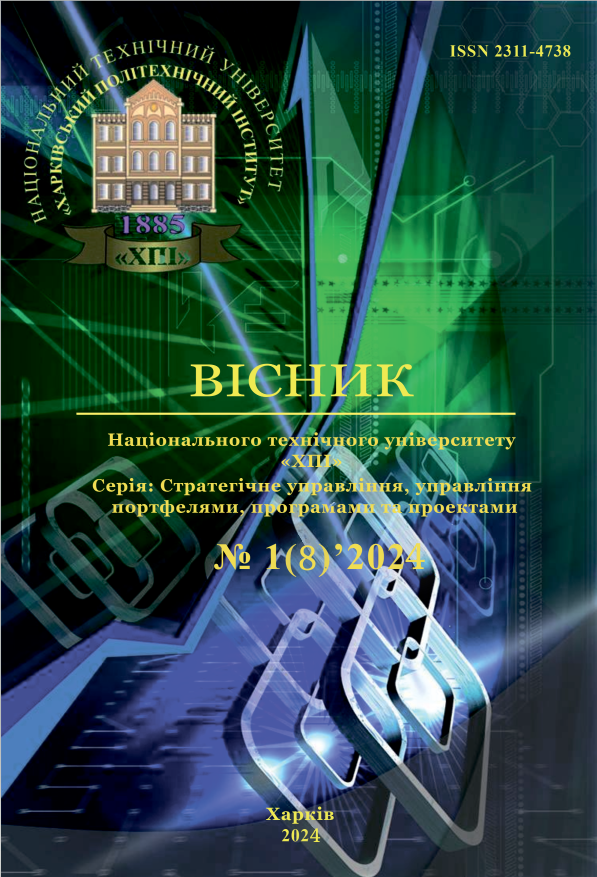MATHEMATICAL MODELS OF IT BUSINESS RISKS ASSESSMENT
DOI:
https://doi.org/10.20998/2413-3000.2024.8.11Keywords:
p-adic models, stock markets, analysis and risk management of stock markets, models in the form of equations in fractional derivatives, dynamic risk management of IT-businessesAbstract
The modern world is a world of almost continuous various disasters. The general concept of risks is closely related to such disasters of a natural, man-made, informational and financial nature. The definition of risks differs greatly among specialists in different industries. Therefore, the formation of general approaches to the description of the indicated phenomena in general terms is relevant. Such general approaches that could lead to the construction of mathematical models of risk analysis and management capable of working in real time. Generally speaking, it is stock and financial markets that instantly react to various environmental changes in a standard way. Such a standard reaction is a sharp change in the rates of financial assets and the collapse of stock markets. Therefore, the authors consider it expedient to start the work with the analysis of the risks of companies and stock markets. The paper analyzed classical approaches to the definition and mathematical modeling of qualitative and quantitative analysis of both the risks of a specific company and the stock market as a whole. An overview of currently existing models for determining and calculating the risks of stock markets is also provided. The hypotheses underlying these models are closely related to probabilistic approaches. Markets are assumed to be stationary and models are assumed to be linear and quadratic. However, due to the complex structure of the current global stock market, these models no longer work. More or less adequate forecasts usually require a large number of observations, work poorly around bifurcations, and do not have a computer implementation that would be able to make forecasts in real time. IT-business markets are changing the fastest, so it was very important to start analyzing the risks of such markets. The work takes the first step in building a "synthetic" model of dynamic calculation and risk management of IT-businesses.
References
Жадность и безрассудство: почему крах FTX сравнивают с кризисом 2008 года; 28.02.2023 ForkLog. URI: https://forklog.com/exclusive/zhadnost-i-bezrassudstvo-pochemu-krah-ftx-sravnivayut-s-krizisom-2008-goda
Didier Sornette, Critical market crashes, Physics Reports 2003, №378, p.1-98. https://doi.org/10.1016/S0370-1573(02)00634-8
FTX Crash: Embattled Crypto Exchange Offloads Crypto Assets to Pay Customers, URI: https://cryptonews.net/news/market/28465875/
Ilknur Koca. Financial model with chaotic analysis. Results in Physics. 51 (2023) 106633
Zharkov V.M. Adelic theory of stock market, URI: https://arxiv.org/ftp/arxiv/papers/1102/1102.2515.pdf
Prosyankina-Zharova T.I., Terentiev O.M., Bidyuk P.I. and Makukha M.P. Features of SAS Enterprise Guide for probabilistic modeling system, macroeconomic analysis and forecasting. Journal of Mathematics and System Science. NY: David Publishing Company, USA, 2016. 112-122 p. ISSN 2159-5291, USA. doi: 10.17265/2159-5291/2016.03.003
Бідюк П.І. Розробка методології системного аналізу, моделювання та оцінювання фінансових ризиків. Номер державної реєстрації теми – 0115U000356. URI: https://report.kpi.ua/files/2016_2813%20.pdf
Vinesh Kumar, Sandeep Kumar Gupta, Rohit Kaushik, Subhask Kumar Verma, and Olena Sakovska, An Intuitionistic Fuzzy Approach to Analysis Financial Risk Tolerance with MATLAB in Business, © The Author(s), under exclusive license to Springer Nature Singapore Pte Ltd. 2023 R. Agrawal et al. (eds.), International Conference on IoT, Intelligent Computing and Security, Lecture Notes in Electrical Engineering 982, https://doi.org/10.1007/978-981-19-8136-4_26
Burtnyak I., Kushnir O., Application of neuron networks to analysis of currency rate. Journal of Vasyl Stefanyk Precarpathian National University. http://journals.pnu.edu.ua Vol. 10, No. 2 (2023), 6-14 doi: 10.15330/jpnu.10.2.6-14
Dmitriy Piskarev Вычисление коэффициента Херста URI: https://www.mql5.com/ru/articles/2930го
May R. Time-delay versus stability in population models with two and three trophic levels. Ecology, 1973, 54, p. 315-325 https://doi.org/10.2307/1934339
Lijuan Li, Front. Energy Res., 24 November 2021 Sec. Process and Energy Systems Engineering. Volume 9 - 2021 |https://doi.org/10.3389/fenrg.2021.786439 URI: https://www.frontiersin.org/articles/10.3389/fenrg.2021.786439/full
Sarboland M., Numerical solution of fractional differential equations with partial derivatives using a multiquadric quasi-interpolation scheme. European Journal of Computational Mechanics. 2018, 27, p. 89-108, https://doi.org/10.1080/17797179.2018.1469833.
Кравець І.О., Лисенко А.Ю. Дослідження Методу Групового Урахування Аргументів для авторегресійних та дистрибутивнолагових моделей. Наукові праці «Комп’ютерні технології», вип. 148, том 160, стор.62 – 73, Миколаїв, Вид-во ЧДУ ім. Петра Могили, 2011.
Downloads
Published
Issue
Section
License

This work is licensed under a Creative Commons Attribution-NonCommercial-ShareAlike 4.0 International License.
Our journal abides by the Creative Commons copyright rights and permissions for open access journals.
Authors who publish with this journal agree to the following terms:
Authors hold the copyright without restrictions and grant the journal right of first publication with the work simultaneously licensed under a Creative Commons Attribution-NonCommercial-ShareAlike 4.0 International License (CC BY-NC-SA 4.0) that allows others to share the work with an acknowledgement of the work's authorship and initial publication in this journal.
Authors are able to enter into separate, additional contractual arrangements for the non-commercial and non-exclusive distribution of the journal's published version of the work (e.g., post it to an institutional repository or publish it in a book), with an acknowledgement of its initial publication in this journal.
Authors are permitted and encouraged to post their published work online (e.g., in institutional repositories or on their website) as it can lead to productive exchanges, as well as earlier and greater citation of published work.

